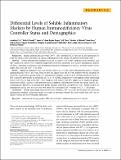Differential Levels of Soluble Inflammatory Markers by Human Immunodeficiency Virus Controller Status and Demographics
Author(s)
Li, Jonathan Z.; Arnold, Kelly B.; Lo, Janet; Dugast, Anne-Sophie; Plants, Jill; Ribaudo, Heather J.; Cesa, Kevin; Heisey, Andrea; Kuritzkes, Daniel R.; Lauffenburger, Douglas A.; Alter, Galit; Landay, Alan; Grinspoon, Steven; Pereyra, Florencia; ... Show more Show less
DownloadLauffenburger_Differential levels.pdf (436.6Kb)
PUBLISHER_CC
Publisher with Creative Commons License
Creative Commons Attribution
Terms of use
Metadata
Show full item recordAbstract
Background. Human immunodeficiency virus (HIV)-1 elite controllers (ECs) represent an ideal population to study the effects of HIV persistence on chronic inflammation in the absence of antiretroviral therapy (ART).
Methods. Twenty inflammatory markers measured in cohorts of ECs, HIV suppressed noncontrollers, and HIV-uninfected controls were compared using rank-based tests and partial least squares discriminant analysis (PLSDA). Spearman correlations were determined among the inflammatory markers, residual viremia by the single-copy assay, and CD4[superscript +] T cell slope.
Results. Significant differences were seen between cohorts in 15 of the soluble inflammatory markers. Human immunodeficiency virus-1 ECs were found to have the highest levels for all of the markers with the exception of RANTES. In particular, median levels of 7 inflammatory markers (soluble CD14 [sCD14], interferon [IFN]-γ, IFN-γ-inducible protein [IP]-10, interleukin [IL]-4, IL-10, sCD40L, and granulocyte-macrophage colony-stimulating factor) were twice as high in the HIV-1 ECs compared with either of the HIV-suppressed or uninfected groups. Multivariate PLSDA analysis of inflammatory markers improved differentiation between the patient cohorts, discerning gender differences in inflammatory profile amongst individuals on suppressive ART. Soluble markers of inflammation in ECs were not associated with either levels of residual HIV-1 viremia or CD4[superscript +] T cell decline.
Conclusions. Despite maintaining relatively low levels of viremia, HIV-1 ECs had elevated levels of a set of key inflammatory markers. Additional studies are needed to determine whether ECs may benefit from ART and to further evaluate the observed gender differences.
Date issued
2014-12Department
Massachusetts Institute of Technology. Department of Biological EngineeringJournal
Open Forum Infectious Diseases
Publisher
Oxford University Press
Citation
Li, J. Z., K. B. Arnold, J. Lo, A.-S. Dugast, J. Plants, H. J. Ribaudo, K. Cesa, et al. “Differential Levels of Soluble Inflammatory Markers by Human Immunodeficiency Virus Controller Status and Demographics.” Open Forum Infectious Diseases 2, no. 1 (December 16, 2014): ofu117–ofu117.
Version: Final published version
ISSN
2328-8957